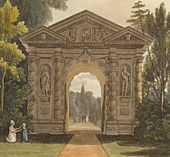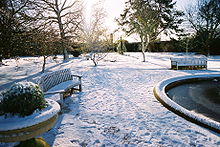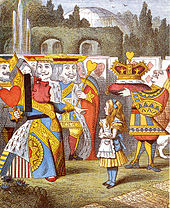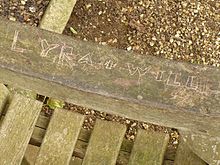- University of Oxford Botanic Garden
-
University of Oxford Botanic Garden 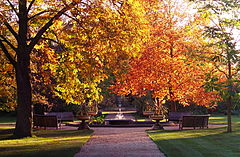
Autumn foliage in the Walled GardenType Botanic Garden Location High Street, Oxford, England Coordinates 51°45′02″N 1°14′54″W / 51.75056°N 1.24833°WCoordinates: 51°45′02″N 1°14′54″W / 51.75056°N 1.24833°W Area 1.8 hectares Operated by University of Oxford Status Open all year The University of Oxford Botanic Garden is an historic botanic garden in Oxford, England. It is the oldest botanic garden in Great Britain and one of the oldest scientific gardens in the world. The garden was founded in 1621 as a physic garden growing plants for medicinal research. Today it contains over 8,000 different plant species on 1.8 hectares (4½ acres). It is one of the most diverse yet compact collections of plants in the world and includes representatives from over 90% of the higher plant families.
Contents
History
Foundation
In 1621, Henry Danvers, 1st Earl of Danby contributed £5,000 (equivalent to £744,000 in 2005)[1] to set up a physic garden for "the glorification of the works of God and for the furtherance of learning". He chose a site on the banks of the River Cherwell at the northeast corner of Christ Church Meadow, belonging to Magdalen College. Part of the land had been a Jewish cemetery until the Jews were expelled from Oxford (and the rest of England) in 1290. Four thousand cartloads of "mucke and dunge" were needed to raise the land above the flood-plain of the River Cherwell.[2]
Catalogue
Humphry Sibthorp began the catalogue of the plants of the garden, Catalogus Plantarum Horti Botanici Oxoniensis. His youngest son was the well-known botanist John Sibthorp (1758–1796), who continued the Catalogus Plantarum.
Layout
 Magdalen College as viewed from the rose gardens on the south side of the High Street, at the front of the Oxford Botanic Garden.
Magdalen College as viewed from the rose gardens on the south side of the High Street, at the front of the Oxford Botanic Garden.
The Garden comprises three sections:
- the Walled Garden, surrounded by the original seventeenth century stonework and home to the Garden's oldest tree, an English yew, Taxus baccata;
- the Glasshouses, which allow the cultivation of plants needing protection from the extremes of British weather; and
- the area outside the walled area between the Walled Garden and the River Cherwell.
A satellite site, the Harcourt Arboretum, is located six miles (10 km) south of Oxford.
The Danby Gateway
The Danby gateway to the Botanic Garden is one of three entrances designed[3] by Nicholas Stone between 1632 and 1633. It is one of the earliest structures in Oxford to use classical, indeed early Baroque, style, preceding his new entrance porch for the University Church of St Mary the Virgin of 1637, and contemporary with Canterbury Quad at St John's College by others. In this highly ornate arch, Stone ignored the new simple classical Palladian style currently fashionable, which had just been introduced to England from Italy by Inigo Jones, and drew his inspiration from an illustration in Serlio's book of archways.[4]
The gateway consists of three bays, each with a pediment. The largest and central bay, containing the segmented arch is recessed, causing its larger pediment to be partially hidden by the flanking smaller pediments of the projecting lateral bays.
The stone work is heavily decorated being bands of alternating vermicelli rustication and plain dressed stone. The pediments of the lateral bays are seemingly supported by circular columns which frame niches containing statues of Charles I and Charles II in classical pose. The tympanum of the central pediment contains a segmented niche containing a bust of the Earl of Danby. It is a Grade I listed structure (ref. 1485/423).
Walled garden
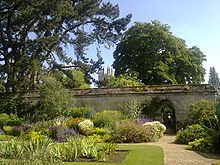 The Magdalen Great Tower obscured behind vegetation in the centre of the gardens.
The Magdalen Great Tower obscured behind vegetation in the centre of the gardens.
- Botanical family beds
The core collection of hardy plants are grouped in long, narrow, oblong beds by botanical family and ordered according to the classification system devised by nineteenth century botanists, Bentham and Hooker. The families represented in the Walled Garden include: Acanthaceae, Amaranthaceae, Amaryllidaceae, Apocynaceae, Araceae, Aristolochiaceae, Berberidaceae, Boraginaceae, Campanulaceae, Caryophyllaceae, Chenopodiaceae, Cistaceae, Commelinaceae, Compositae, Convolvulaceae, Crassulaceae, Cruciferae, Cyperaceae, Dioscoreaceae, Dipsacaceae, Euphorbiaceae, Gentianaceae, Geraniaceae, Gramineae, Hypericaceae, Iridaceae, Juncaceae, Labiatae, Leguminosae, Liliaceae, Linaceae, Loasaceae, Lythraceae, Malvaceae, Onagraceae, Paeoniaceae, Papaveraceae, Phytolaccaceae, Plantaginaceae, Plumbaginaceae, Polemoniaceae, Polygonaceae, Portulacaceae, Primulaceae, Ranunculaceae, Rosaceae, Rubiaceae, Rutaceae, Saxifragaceae, Solanaceae, Umbelliferae, Urticaceae, Verbenaceae, Violaceae.
In 1983, The National Council for the Conservation of Plants and Gardens (NCCPG) chose Oxford Botanic Garden to cultivate the national collection of euphorbia. One of the rarest plants in the collection is Euphorbia stygiana, with only ten plants left existing in the wild. The Garden is propagating the species as quickly as possible to reduce the possibility of it becoming extinct.
- Economic beds
Eight beds in the southwest corner of the Garden represent plants with links to modern medicine. Examples include Galega officinalis which contains galegine and guanidine, upon which the anti-diabetic drug metformin is modelled and Artemisia annua which is the source of the anti-malarial drug artemisinin.
- Variegated plants
Two beds in the northwest corner of the Garden contain variegated plants laid out according to the classification system devised at the Garden by Professor C. D. Darlington and former Superintendent J. K. Burras in the 1970s. Examples include Aegopodium podagraria 'Variegatum', a highly invasive plant introduced in the Middle Ages as a potherb boiled like spinach, and used in the treatment of gout; Weigela praecdox 'Variegata', a compact shrub suitable for a small garden; and Cornus alternifolia 'Argentea' known as the pagoda dogwood.
- Hybrids and parents
One bed in the north end of the garden contains some hybrids between species from the same genus. An example includes Viburnum × bodnantense, growing with its parents, V. farreri and V. grandiflorum.
- Bearded irises
One bed in the northwest corner of the garden contains a display of bearded irises each May. Examples include Iris 'Eileen' and Iris 'Golden Encore'. Some of the varieties grown in the Garden are not grown anywhere else.
- Wall borders
The borders along the foot of the wall contain collections that thrive in the microclimate created by the Wall. The cool east border includes ferns, Stachyurus praecox, Astrantia major, and Equisetum telmateia. The dry, shaded south border includes Jasminum nudiflorum, Hydrangea anomala petiolaris, Lonicera fragrantissima and L. × purpusii, and the unusual and rare Ercilla volubilis and Arisarum proboscoideum. The southeast border contains the bamboo collection.
The west and north borders contain plant collections grouped by their geographical origin. The Sino-Japanese collection at the southwest border includes Clerodendrum bungei. The North American collection at the west border includes Fremontodendron californicum. The European collection at the northwest border includes Cliantus puniceus. The Mediterranean collection at the north border includes Euphorbia myrsinites. The South American collection at the north border includes Acca sellowiana. The South African collection at the northeast border includes Kniphofia caulescens.
Glasshouses
- Conservatory
The house is an aluminium replica of the original 1893 wooden house and grows seasonal flowers such as primulas, abutilons, fuchsias, and achimenes. Various exhibitions which change throughout the year are displayed in the centre area.
- Alpine House
Plants which cannot grow to their full potential outside are displayed in this house. The displays are changed regularly so that there is always something in flower.
- Fernery
A collection of ferns from around the world are housed here including Platycerium bifurcatum (stag's horn fern), Lygodium japonicum (a climbing fern), and Tricomanes speciosum (a filmy fern native to western Britain).
- Tropical Lily House
The tank in the lily house built in 1851 by Professor Charles Daubeny, Keeper of the Garden at the time, is the oldest existing part of the glasshouses. Tropical water lilies grow in boxes in the tank, including the hybrid Nymphaea × daubenyana named in honour of Professor Daubeny in 1874. Also growing in the house are economic plants including bananas, sugar cane, and rice, and the papyrus reed, Cyperus papyrus, a native of river banks in the Middle East. Flowering high in the glasshouse is the yellow-flowered Allamanda cathartica.
- Orchid House
This house grows a collection of orchids aimed at showing the diversity of growth habit in the Orchidaceae, the largest family of flowering plants in the world. Bromeliads such as Ananas comosus, or pineapple, are also grown in the house.
- Palm House
The largest glasshouse in the Garden, this house grows palms and a large number of economic plants including citrus fruits, pepper, sweet potato, pawpaw, olive, coffee, ginger, coconut, cocoa, cotton, and oil palm. There is a collection of cycads which look like palms but are unrelated. Several important teaching collections present include the Acanthaceae including the shrimp plant Justicia brandegeana, the Gesneriaceae, and a large number of Begonia species.
- Succulent House
Plants in this house come from arid areas of the world and demonstrate ways in which plant forms economise the use of water.
Outside the walled garden
- Rock Garden
- Bog Garden
- Herbaceous Border
- Autumn Border
- Glasshouse Borders
- Merton Borders
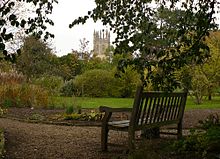 The wooden bench at the back of the Botanic Garden featured in The Amber Spyglass by Philip Pullman.
The wooden bench at the back of the Botanic Garden featured in The Amber Spyglass by Philip Pullman.
In literature
The Garden was the site of frequent visits in the 1860s by Oxford mathematics professor Charles Lutwidge Dodgson (pen name Lewis Carroll) and the Liddell children, Alice and her sisters. Like many of the places and people of Oxford, it was a source of inspiration for Carroll's stories in Alice's Adventures in Wonderland. The Garden's waterlily house can be seen in the background of Sir John Tenniel's illustration of "The Queen's Croquet-Ground".
Another Oxford professor and author, J. R. R. Tolkien, often spent his time at the garden reposing under his favourite tree, Pinus nigra. The enormous Austrian pine is much like the Ents of his The Lord of the Rings story,[citation needed] the walking, talking tree-people of Middle-earth.
In the Evelyn Waugh novel Brideshead Revisited, Lord Sebastian Flyte takes Charles Ryder "to see the ivy" soon after they first meet. As he says, "Oh, Charles, what a lot you have to learn! There's a beautiful arch there and more different kinds of ivy than I knew existed. I don't know where I should be without the Botanical gardens" (Chapter One).
In Philip Pullman's trilogy of novels His Dark Materials, a bench in the back of the garden is one of the locations/objects that stand parallel in the two different worlds that the protagonists, Lyra Belacqua and Will Parry, live in.[5] In the last chapter of the trilogy, both promised to sit on the bench for an hour at noon on Midsummer's day every year so that perhaps they may feel each other's presence next to one another in their own worlds.
See also
- Cambridge University Botanic Garden
- Timothy Walker (botanist), Horti Praefectus (Director) of the Garden since 1988
Notes
- ^ Lawrence H. Officer, "Purchasing Power of British Pounds from 1264 to 2005". MeasuringWorth.com, 2006, accessed 11 December 2006.
- ^ Headington.org (whose date for the gateway is wrong).
- ^ "probably designed", according to Colvin 1995.
- ^ Pevsner, p.267. Pevsner is almost certainly referring to Tutte l'opere d'architettura, Volume 6. p17. "Libro estraordinario" published in 1584.
- ^ Leonard, Bill, The Oxford of Inspector Morse Location Guides, Oxford (2004) p.198. ISBN 0-9547671-1-X.
References
- Colvin, Howard, A Biographical Dictionary of British Architects, 1600-1840 3rd ed. (Yale University Press) 1995, s.v. "Stone, Nicholas"
- Jennifer Sherwood, Nikolaus Pevsner (1974). The Buildings of England, Oxfordshire. New Haven and London: Yale University Press. ISBN 0 300 09639 9.
External links
Categories:- 1621 establishments in England
- Botanical gardens in England
- Gardens in Oxfordshire
- Alice in Wonderland
- Culture of the University of Oxford
- Departments of the University of Oxford
- University of Oxford sites
- History of the University of Oxford
- Parks and open spaces in Oxford
- Visitor attractions in Oxford
- Grade I listed buildings in Oxford
Wikimedia Foundation. 2010.

